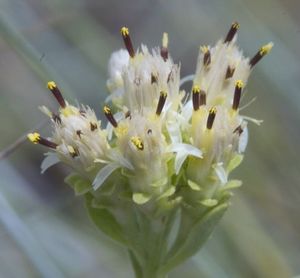Sericocarpus rigidus
- Scientific Name: Sericocarpus rigidus
- Family: Asteraceae
- Common Names: White-top aster. Columbian white-top aster, Curtus's aster.
- Synonyms/Misapplications: Aster curtus
- Codon: SERRIG
Taxonomy
| Sericocarpus rigidus | |
|---|---|
| Scientific classification | |
| Kingdom: | Plantae |
| Subkingdom: | Tracheobionta |
| Phylum: | Spermatophyta |
| Subphylum: | Magnoliophyta |
| Class: | Magnoliopsida |
| Subclass: | Asteranae |
| Order: | Asterales |
| Family: | Asteraceae |
| Genus: | Sericocarpus Greene |
| Species: | Sericocarpus rigidus Lindl. |
Description
Rhizomatous perennial with a rhizomatous habit, stems usually unbranches, glabrous, and growing in colonies of many shoots.
Leaves: Lowermost leaves reduced and early-deciduous, the largest ones a little above the base. 2.5-3.5 cm. Long and 5-9 mm. wide, oblanceolate, sessile; those leaves above numerous and gradually reduced; often scabrous on the midrib beneath, and with stiff, short hairs on the margins.
Flowering heads in a tights terminal cluster; involucre 7-9 mm. high, narrow, the bracts imbricate, white and papery below with a light green herbaceous tip; rays usually 2, shorter than the capillary pappus, 1-3 mm. long, white; disk flowers 9-21, cream yellowish, with purple anthers. Distinguished by few and inconspicuous ray flowers, and colony-forming habit.
Bloom period
July-August[3]
Distribution
Sericocarpus rigidus is considered threatened in Oregon and a sensetive species in Washington.[3] Endemic to low elevation prairies from southern Vancouver Island, BC, to central Oregon.[4] S. rigidus is found in several south Salish Sea prairies, with the majority of its populations at Fort Lewis. Individual stands may be substantial in size because of its rhizomatous habit, but large distances may span between populations because the isolation and fragmentation of prairie habitat. This species is fairly intolerant of disturbance and is more likely to be found where there is a minimum of 32 percent native bunchgrass cover, because it establishes in gaps between clumps.[5] Maintaining areas of high ratios of native to exotic taxa with bunchgrass presence and low disturbance is key to the conservation of this species.[3]
Habitat
Prairies, meadows, and open areas at low elevations. One study found that S. rigidus benefits from the activity of Mazama pocket gophers (Thomomys mazama). [6] Historically, fire helped to maintain these open grasslands by restricting Douglas-fir invasion. Associated species include snowberry (Symphoricarpos albus), serviceberry (Amelanchier alnifolia), goldenrod (Solidago spp.), woolly sunflower (Eriophyllum lanatum), and Viola adunca.[2]
Soil Texture
Most commonly found on glacial outwash soils, but also occurs on clayey soils and bedrock. When germinating, use a 35-35-25-5 potting mix (sand, compost, pertile or vermiculite, and pumice).
Moisture Regime
Dry soil- Able to tolerate drought conditions during summer months.
Shade Tolerance
Partial to full shade- shade tolerant.
Photo Gallery
- ↑ WTU Herbarium, Burke Museum, & University of Washington. Retrieved from https://biology.burke.washington.edu/herbarium/imagecollection/taxon.php?Taxon=Sericocarpus%20rigidus
- ↑ 2.0 2.1 Rare Plant Field Guide: WA - DNR. Retrieved from https://www.dnr.wa.gov/NHPfieldguide
- ↑ 3.0 3.1 3.2 Bowcutt, F., & Hamman, Sarah. (2016). Vascular plants of the South Sound prairies (First ed.). Olympia, Washington: The Evergreen State College Press.
- ↑ Hitchcock, C. L., Cronquist, A., Giblin, D., & Legler, B. et al. (2018). Flora of the Pacific Northwest: an illustrated manual. Seattle: University of Washington Press.
- ↑ Clampitt, Christopher A. 1993. "Effects of Human Disturbances on Prairies and the Regional Endemic Aster curtus in Western Washington." Northwest Science 67(3):163-169.
- ↑ Stinson, Derek W. 2005. "Washington State Status Report for the Mazama Pocket Gopher, Streaked Horned Lark, and Taylor's Checkerspot." Washington Department of Fish and Wildlife, Olympia. wdfw.wa.gov/publications/00390




